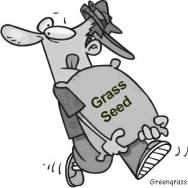My Grass Seed did not grow

Author: Jonathan Green | July 11, 2011
Over the years, we have heard of homeowners struggling to establish newly planted grass seed. If there is grass seed growing in the carpet of my car and in cracks in your sidewalk, why is it not growing where it is supposed to, on your lawn? The natural tendency is to blame the grass seed, but we need to establish some realistic expectations and delve deeper into the reasons why your grass seed did not grow.
Many homeowners apply grass seed during spring months after they rake up their yards and find bare spots. As we all know spring weather can vary greatly each year in the same area. The main reason grass seed does not germinate quickly during spring months is cool and wet weather. Grass seed that is planted in soil temperatures below 50 degrees just will not grow potentially for many weeks if it does not want to. Usually for the soil temperatures to reach 50 degrees you need 7-10 days of air temperatures to reach 60 plus degrees. Would you rather swim in the ocean in April or August? August is the best choice because the water is much warmer. The same goes for growing grass seed, it likes to germinate in August more than April because of warm soil conditions. Water is necessary for seeds to germinate, but too much water can hinder germination too. Excessive spring rains can delay germination and while watering newly planted grass seed is good for growth, overwatering will not make the grass seed grow any faster. So, the rule of thumb is “be patient” when seeding in the spring.
The species of grass seed you sow will help to determine when to expect germination. Ryegrass is the quickest species of grass to germinate. In the correct conditions, ryegrass can germinate in 5-7 days, usually 10-14 days if it is not too cold (see above!). Tall, chewings and creeping fescues are the next species to germinate, usually 14-21 days. The turtle in the race is Kentucky bluegrass; this species can take 21-28 days to germinate. Let’s clarify what “germinate” means too, germinate means, “start to grow” not fill in to a complete lawn. Be aware of the grass seed species in the mixture you buy and percentages listed. A mixture containing only 10% Ryegrass will not germinate that fast if the rest of the mixture contains Kentucky bluegrass and Fescues.
All grass seed needs some level of sunlight to grow, to produce chlorophyll and photosynthesis. As spring comes along and the tree canopy increases, less sunlight is getting to the grass plants. If your shaded area receives only 1-2 hours of sunlight a day you may have trouble growing grass. If this same area receives 3-4 hours of sunlight, whether filtered or not, your chances of success increase greatly. In shaded areas, trees and grass seed are like David and Goliath. Who do you think will use most of the moisture and nutrients in the soil? Frequently shaded areas have low soil pH value conducive to growing trees and not grass seed.
Why are you re-seeding this area? Was it full of weeds, killed from drought stress, insects or disease? When is the last time you tested your soil, never? Shame on you! Test the soil in areas that you are having trouble growing grass seed before you waste money on grass seed and fertilizer. Homeowner test kits are available at garden and hardware stores or send your sample to your local university extension office for analysis. Jonathan Green offers a Soil pH Test Kit that is easy to do and you will have your results in five minutes. How can you grow grass seed or any plant effectively if you do not know the parameters of your soil? How can you expect to grow a great lawn in the soil between the curb and sidewalk where it gets foot and dog traffic, road salt, etc.? You wouldn’t plant your tomatoes in that awful soil would you? How do you expect grass to grow there? The moral of the story is to improve the soil after testing with soil amendments to create an environment that the grass seed wants to grow in. Did you useJonathan Green New Seeding Lawn Fertilizer when seeding? This will supply the nutrients necessary to get new seedling off to a good start.
Did your new grass seed fail because you applied weed control products that prevent grass seed from growing? Pre-emergent crabgrass preventers do not allow new grass seed to grow for 3-4 months after application unless you use one containing Siduron or Tupersan like Jonathan Green Crabgrass Preventer plus New Seeding Lawn Fertilizer. This product will prevent crabgrass and grassy weeds from germinating and lets you seed on the same day without injuring seedlings. You cannot apply grass seed for 3-4 weeks after any broadleaf weed controls have been applied to the lawn. If you sow grass seed you need to have the seed germinate and be mowed 3-4 times before you can apply broadleaf or grassy weed control products.
We have hundreds of certified laboratory tests on the grass seed that we supply to the market that reflects viable germination. We are required to label grass seed packages according to federal and state seed laws. If the lab tests show good germination rates, why didn’t it germinate on your lawn? Try this experiment, get a Styrofoam coffee cup, put paper toweling in it, put in one inch of water, sprinkle the grass seed you just bought on top of the paper toweling, put it in a warm, sunny window, check it every few days and water if necessary so it does not dry out. The grass seed will germinate in the cup after 10-14 days. If it worked in this experiment you have to figure out why it did not grow on your lawn. You need to determine why it failed, read this article again, and do not always blame the grass seed.
Footnote by Greengrass:
For warm season (drought resistant grasses), all the above plus the best time to sow seed is when the soil temperature is above 20C and there is a high probability of several days of good soil moisture. Seed does not grow well in the heat of summer or the cold of winter, and is generally sown in late spring or autumn (providing seedlings will have developed sufficiently by winter to withstand frost). Below 20 C, germination may still occur but seedlings will be slower to establish and more susceptible to moisture stress and waterlogging.
For more information about grass seed or if you have any questions about your lawn, we would be pleased to answer any questions FREE – see us on
Google “Lawns in Spain” or http://www.lawnsinspain.com Contact: lawnsinspain@yahoo.com or phone 676 863 778



